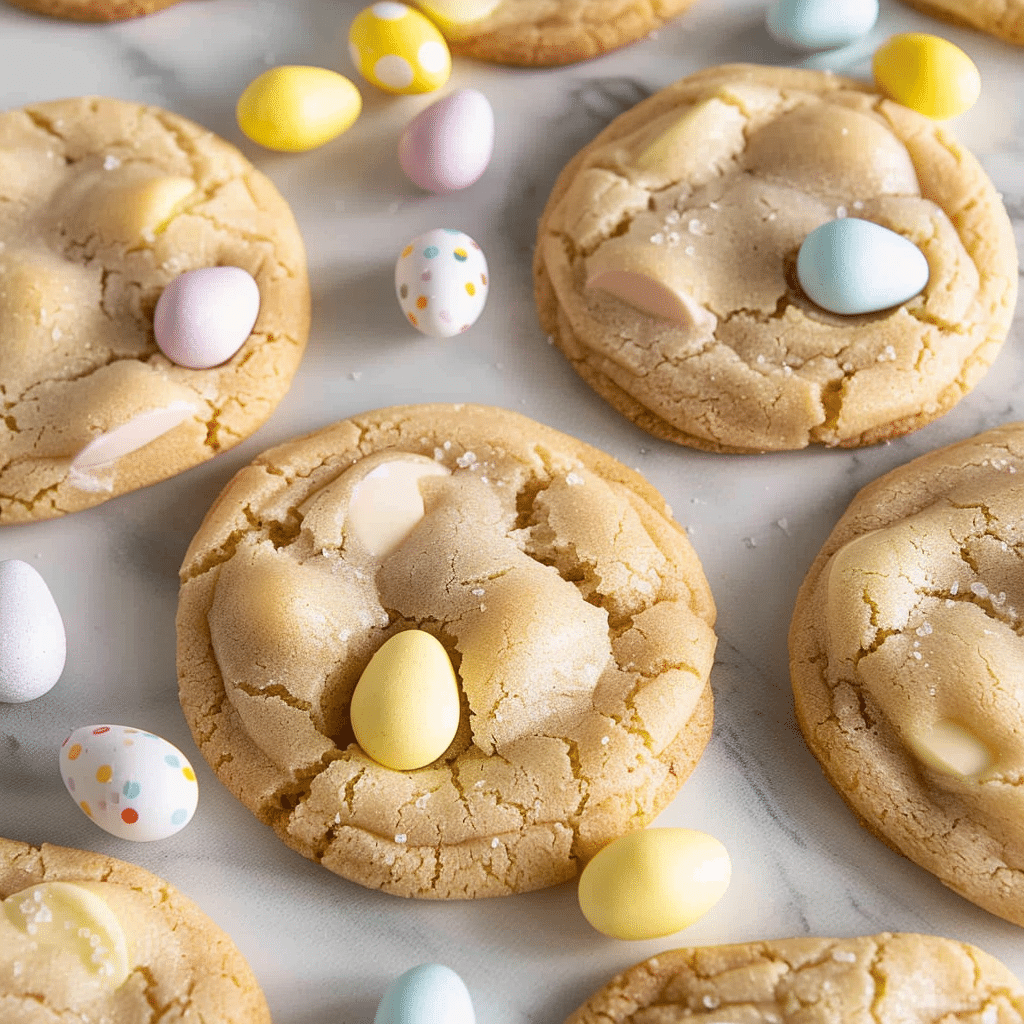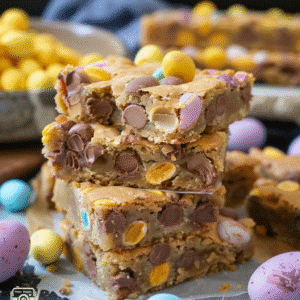Mini egg cookies have quickly become my favorite go-to when I want a treat that’s festive, fun, and utterly delicious. These cookies blend a rich, buttery dough with crunchy candy-coated chocolate eggs, delivering a soft and chewy bite that feels perfect for spring but is too good to limit to just one season.
Inspired by Easter traditions yet ideal any time of year, they’ve found a permanent spot in my baking lineup. In this article, I’ll share my foolproof recipe, address common baking questions like “Do eggs make cookies rise?”, and include options for those avoiding eggs. Whether you’re just starting out or a baking pro, these cookies are a simple crowd-pleaser you’ll return to again and again.
Table of Contents
Table of Contents
- A cozy memory behind the recipe
- Why mini egg cookies just work every time
- Step-by-step instructions that guarantee success
- Why this mini egg cookies recipe stands out
- Why go egg-free with mini egg cookies
- How to make mini egg cookies without eggs
- The impact of extra eggs on cookie texture
- Getting the texture just right in mini egg cookies
- Understanding the role of eggs in cookie rise
- Balancing rise with texture in mini egg cookies
- What changes in flavor without eggs
- Texture versus taste in mini egg cookies
- How to elevate your mini egg cookies
- Making mini egg cookies your own
- Frequently Asked Questions About Mini Egg Cookies
- What happens if you use too many eggs in mini egg cookies?
- What happens when mini egg cookies have too much egg?
- Do eggs make mini egg cookies rise?
- Do eggless mini egg cookies taste different?
Mini Egg Cookies and My Baking Story
A cozy memory behind the recipe
Mini egg cookies hold a special place in my baking journey. When I was still learning the ropes, worried about overmixing dough or flattening every batch, a friend gifted me a tin of mini egg cookies during Easter. They were soft in the center with just the right crisp around the edges. The candy shells added bursts of color and crunch that felt so festive. That moment ignited my passion for baking these delicious treats. I soon made my own batch using what I had at home, tweaking the recipe until it became my go-to.
Since then, I’ve baked these cookies for everything from baby showers to casual weekends in Toronto, especially when the spring sun warms the city. The best part? You don’t need fancy tools or rare ingredients. These cookies are joyful to make, especially with little helpers sneaking mini eggs from the bowl. They’ve become a seasonal tradition, much like pulling out pastel decorations or spotting the first tulips on Queen Street. If you love themed baking, they pair beautifully with Philadelphia Easter mini cheesecakes or a refreshing mini eggs cheesecake dip.
Why mini egg cookies just work every time
There’s a little magic baked into this recipe. The dough blends brown and white sugar for a rich, caramel-like flavor in every bite. The egg helps bind everything into a chewy, tender center. Chopping the mini eggs creates colorful chocolate bursts throughout, and baking just until set keeps them soft for days.
This recipe is endlessly adaptable, too. Swap half the butter for browned butter to deepen the flavor or add white chocolate chips alongside the chopped mini eggs. These cookies also play well with other festive desserts. Try them with easter chocolate egg cookies or something lighter like frozen Greek yogurt bars. Whether you’re baking for a holiday or just because, these mini egg cookies always deliver.
Print
Mini Egg Cookies Recipe: Soft, Easy, Irresistible
- Total Time: 19 minutes
- Yield: 16 cookies 1x
- Diet: Vegetarian
Description
These mini egg cookies are soft, buttery, and loaded with crunchy chocolate mini eggs. A festive, easy treat that’s perfect for spring or anytime you crave a colorful, chocolate-filled cookie.
Ingredients
½ cup salted butter, softened
½ cup granulated sugar
½ cup light brown sugar
1 teaspoon pure vanilla extract
1 egg
1 ½ cups all-purpose flour
½ teaspoon baking soda
¼ teaspoon baking powder
½ teaspoon fine sea salt
1 cup mini eggs, coarsely chopped
Instructions
1. Preheat oven to 375°F. Line two large baking sheets with parchment paper or silicone baking mats.
2. In a medium bowl, whisk together flour, baking soda, baking powder, and salt. Set aside.
3. In a large bowl, beat butter, granulated sugar, and brown sugar until light and fluffy.
4. Add the egg and vanilla. Beat until combined.
5. Gradually add the dry ingredients. Mix on low speed until fully combined.
6. Stir in chopped mini eggs by hand.
7. Scoop dough into balls using a 1½ tablespoon cookie scoop. Place evenly spaced on prepared sheets.
8. Bake for 8–9 minutes until edges are set and centers look slightly underbaked.
9. Cool on the baking sheet for 5–10 minutes, then transfer to a wire rack to cool completely.
Notes
To make these egg-free, substitute ¼ cup unsweetened applesauce or 1 tablespoon flaxseed meal + 3 tablespoons water.
Chilling the dough for 30 minutes helps cookies hold shape and deepen flavor.
Store in an airtight container for up to 5 days, or freeze for longer storage.
- Prep Time: 10 minutes
- Cook Time: 9 minutes
- Category: Dessert
- Method: Baking
- Cuisine: North American
Nutrition
- Serving Size: 1 cookie
- Calories: 160
- Sugar: 14g
- Sodium: 90mg
- Fat: 8g
- Saturated Fat: 5g
- Unsaturated Fat: 2g
- Trans Fat: 0g
- Carbohydrates: 21g
- Fiber: 0.5g
- Protein: 2g
- Cholesterol: 25mg
The Best Mini Egg Cookies Recipe
Step-by-step instructions that guarantee success
Mini egg cookies owe their magic not just to ingredients but to a method perfected in everyday kitchens. Begin by preheating your oven to 375°F and lining two large baking sheets with parchment paper or silicone mats. In a medium bowl, whisk together flour, baking soda, baking powder, and sea salt. This blend creates the essential structure for your cookies, giving them the perfect chewy texture.
In a large mixing bowl, cream the softened butter with both granulated and light brown sugars on medium-high speed until the mixture is light and fluffy, about one minute. This creaming step is crucial because it traps air, helping the cookies rise slightly and achieve that sought-after contrast of soft center and crisp edges. Add an egg and pure vanilla extract, mixing until just combined. Slowly fold in the dry ingredients on low speed, ensuring a smooth dough.

Hand-stir in coarsely chopped mini eggs last to keep chunks intact and evenly distributed. Using a 1½ tablespoon cookie scoop, portion dough balls and gently roll them before placing on the prepared sheets. Bake for 8 to 9 minutes until the tops set with a light golden hue. Allow the cookies to cool on the baking sheets for 5 to 10 minutes, then transfer them to a wire rack to cool completely.
These cookies store well in airtight containers for several days and freeze beautifully, whether baked or as raw dough balls. Planning ahead? Pair these festive treats with no-bake mini egg cheesecake or serve alongside easter egg rocky road for a colorful dessert spread that’s perfect for entertaining.
Why this mini egg cookies recipe stands out
What makes this recipe special is its perfect balance of texture and simplicity. With a single egg and carefully calibrated leavening, these cookies rise just enough without becoming cakey. The duo of granulated and brown sugars adds depth and chewiness, while the mini eggs provide sweet bursts without overwhelming the dough.
Unlike recipes that spread too thin or lose shape, this dough holds firm thanks to a balanced flour-to-fat ratio. Mini eggs bring their own sweetness and crunch, so no extra chocolate is needed. But if you love a more indulgent bite, feel free to toss in white chocolate chunks or drizzle melted dark chocolate after baking. This recipe has quickly become a staple in my kitchen, just like ground chicken fried rice, which always makes casual family gatherings feel a little more special.
Mini Egg Cookies No Egg – A Delicious Alternative
Why go egg-free with mini egg cookies
Mini egg cookies are a beloved treat, but not everyone can or chooses to bake with eggs. Whether it’s due to allergies, dietary preferences, or simply running low on eggs, having an egg-free recipe that still delivers on flavor and texture is a game changer. The good news? Soft, chewy cookies packed with chocolatey mini eggs don’t require eggs to taste amazing.
By swapping eggs with ingredients like unsweetened applesauce or mashed banana, you maintain the cookie’s moisture and binding without compromising its tender, melt-in-your-mouth feel. These egg substitutes provide enough lift and structure so the dough holds together beautifully. In fact, some bakers find egg-free dough easier to work with and less prone to overmixing. For more egg-free dessert ideas, pair these cookies with refreshing frozen Greek yogurt bars or get festive with mini eggs cheesecake dip-both are excellent choices for inclusive holiday dessert spreads.
How to make mini egg cookies without eggs
Start with the classic cookie ingredients: flour, sugars, leavening agents, butter, and those colorful mini eggs. Replace each egg with either ¼ cup unsweetened applesauce, 3 tablespoons aquafaba, or a flaxseed “egg” made by mixing 1 tablespoon ground flaxseed with 3 tablespoons water and letting it sit for 5 minutes.
Stick to the standard process: cream the butter and sugars, mix in your egg substitute and vanilla, then slowly incorporate the dry ingredients. Gently stir in the chopped mini eggs, scoop the dough onto baking sheets, and bake according to the instructions.The cookies will come out slightly softer but still wonderfully chewy and flavorful.
These egg-free mini egg cookies are perfect for gifting. Wrap them alongside mini egg cheesecake cookie bars or pack them up with a slice of easter chocolate egg cookies for a thoughtful, festive treat. No matter the version, these cookies remain a favorite, bringing joy to every spring table and beyond.
What Happens If You Use Too Many Eggs in Mini Egg Cookies?
The impact of extra eggs on cookie texture
Knowing how too many eggs affect your mini egg cookies can save your bake from disappointment. Eggs contribute structure, moisture, and help the cookie rise, but moderation is key. Adding too many eggs often leads to cookies that are overly soft and spongy rather than delightfully chewy and crisp around the edges.

Extra eggs upset the balance between sugar and fat, causing the dough to spread differently. Instead of that perfect tender-chewy texture, you may end up with cakier cookies that lack the buttery density we crave. For mini egg cookies, using one egg usually hits the sweet spot, It creates a texture that’s tender yet holds its shape. Using more than that tips the cookie closer to a cake than a cookie.
This doesn’t mean egg-rich doughs are bad, just different. If you prefer the classic cookie texture, it’s best to stick with the recipe’s egg quantity. For a similar balance of richness and texture, check out my mini egg cheesecake recipe, which also keeps egg amounts minimal for creamy, satisfying results. You could also pair these with an easy side like ground chicken fried rice for a simple family dinner followed by dessert.
Getting the texture just right in mini egg cookies
Texture is everything in mini egg cookies. Too many eggs create a dough that’s harder to work with and can cause cookies to spread unevenly or turn rubbery. One whole egg provides just enough binding and lift while maintaining a moist, chewy center. This approach ensures each cookie has the ideal soft pull and crispy edge.
Unless you want a cake-like cookie intentionally, resist the urge to add more eggs. Recipes like Philadelphia Easter mini cheesecakes also keep eggs low for a smooth, rich finish without puffiness. The principle is clear: aim for structure and chew, not sponge.
Baking is all about balance. With mini egg cookies, precision in eggs helps achieve those golden edges, soft middles, and chocolate-speckled charm that keep them irresistible, Whether baking for the first time or doubling the batch.
Do Eggs Make Mini Egg Cookies Rise?
Understanding the role of eggs in cookie rise
Many bakers wonder whether eggs actually make mini egg cookies rise. The truth is, eggs play a supporting but important role in the process. While eggs are not the main leavening agent, that job belongs to baking soda and baking powder, they provide essential structure and a gentle lift. In mini egg cookies, eggs help bind the dough and give it enough strength to rise slightly as it bakes.
When heated, the proteins in eggs firm up, helping the cookie hold its shape and support the tiny air pockets formed by the leaveners. Without eggs, cookies might spread too thin or lose their form entirely. Egg-free versions rely on alternatives like aquafaba or flaxseed gel to mimic this effect and maintain structure.
Using just one egg strikes the perfect balance. It adds enough rise to create a tender, chewy center while keeping the edges crisp without turning cakey. Curious about other treats that handle rise differently? My no-bake mini egg cheesecake skips rising entirely and focuses on a creamy, set texture instead. Another great option is the mini egg cheesecake, which balances egg with richness for a classic finish.
Balancing rise with texture in mini egg cookies
Achieving the ideal rise in mini egg cookies means balancing fluffiness with chewiness. Too much rise creates puffed, cakey cookies, which is not the goal here. The single egg in this recipe gives just the right lift to maintain a moist, chewy texture while preserving the buttery cookie base.
Temperature and mixing technique matter too. Always start with room temperature ingredients and avoid overmixing after adding the egg to prevent tough, dry cookies. The end result is a golden cookie with perfect height, softness, and bursts of crunchy chocolate from the mini eggs.
For a fun pairing, serve them alongside easter egg rocky road or display with mini egg cheesecake cookie bars for a vibrant dessert table. These cookies deliver rise, flavor, and crowd-pleasing charm, making them ideal for any celebration or cozy evening at home.

Do Eggless Mini Egg Cookies Taste Different?
What changes in flavor without eggs
When baking mini egg cookies without eggs, many wonder if the flavor suffers. The good news is that eggless versions can still be delicious, though there’s a subtle difference. Eggs mainly contribute moisture and structure, along with a gentle richness that enhances flavor. When replaced with alternatives like applesauce, mashed banana, or flaxseed gel, the taste shifts slightly but remains enjoyable.
Applesauce brings a mild fruity sweetness, banana adds a natural sugary note, and flaxseed contributes a light nutty undertone. None of these overpower the chocolatey, buttery base of mini egg cookies, but they do add a nuanced twist that some find pleasantly unique. Pairing these egg-free cookies with desserts like frozen Greek yogurt bars or mini egg cheesecake dip can elevate your dessert spread with both familiarity and variety.
Texture versus taste in mini egg cookies
Texture differences are often more noticeable than flavor when making eggless mini egg cookies. Eggs help create a chewy, tender structure, so without them, cookies may be slightly denser or softer depending on the substitute used. With proper measurements and mixing, however, the dough still bakes into cookies that are golden, chewy, and fully satisfying.
Eggless cookies tend to spread less, resulting in thicker, richer bites with less airiness. This can enhance moisture, especially when banana is used. If you prefer soft, melt-in-your-mouth cookies, the egg-free version might quickly become a favorite.
For a festive flair, serve them with Easter chocolate egg cookies or bundle them with mini egg cheesecake cookie bars for a thoughtful holiday gift. Whether with or without eggs, mini egg cookies bring the perfect blend of fun, flavor, and that unmistakable crunchy mini egg surprise.
Final Tips for the Best Mini Egg Cookies Ever
How to elevate your mini egg cookies
Nailing the perfect mini egg cookies means focusing on the little things. Choose top-notch ingredients like fresh butter, pure vanilla extract, and roughly chopped mini eggs for that ideal balance of buttery dough and crisp chocolate crunch. Precise flour measurement and thorough creaming of butter and sugars are crucial because they influence how your mini egg cookies rise and their final texture.
While not mandatory, chilling the dough for 20 to 30 minutes helps intensify flavor and keeps your cookies from spreading too thin. Want thicker mini egg cookies? Extend the chill time. Prefer soft, gooey centers? Bake the dough right away. Always watch your baking time and pull the cookies out when edges turn golden and centers remain slightly soft. They’ll finish firming on the sheet.
For a crowd-pleasing dessert table, pair your mini egg cookies with Philadelphia Easter mini cheesecakes or serve alongside mini egg cheesecake bars. This combo brings color, texture, and seasonal fun to any celebration.
Making mini egg cookies your own
The beauty of mini egg cookies is their versatility. Add a caramel twist with toffee bits, or enhance the chocolatey flavor by mixing in white chocolate chips. For a kid-friendly touch, press whole mini eggs on top before baking to give them that classic bakery-style look. Adults might appreciate a light sprinkle of flaky sea salt to balance sweetness and enhance chocolate flavor.
Feel free to experiment. Swap vanilla for almond extract, try browned butter for extra richness, or roll dough balls in sugar before baking for a subtle crunch. Just keep in mind the recipe’s balance is key, so any tweaks should complement the cookie’s classic charm rather than overpower it.
Whether you’re baking a small batch or preparing a party-sized haul, mini egg cookies bring joy with every bite. With these tips and your personal touch, they’re bound to become a seasonal favorite and maybe even a year-round staple.
Conclusion
Mini egg cookies go beyond being just a colorful springtime treat. They’ve become a beloved staple for any kitchen that appreciates vibrant, chocolate-studded baked goods year-round. Whether you choose the classic egg version or a plant-based alternative, the secret lies in balancing chewy texture, rich buttery notes, and that signature crunch from the mini eggs.
In this guide, we’ve covered how eggs influence the rise, structure, and mouthfeel of these cookies, as well as how egg-free substitutes can deliver equally delightful results. We’ve discussed the pitfalls of using too many eggs and how to avoid overly cakey cookies, along with creative ways to boost flavor with additions like browned butter or white chocolate chips.
No matter your experience level, mini egg cookies offer flexibility, fun, and flavor that keep everyone reaching for seconds. They’re perfect for Easter brunches, weekend baking sessions, or paired with show-stopping sweets like mini egg cheesecake cookie bars or easter chocolate egg cookies.
If you ever wondered whether one cookie recipe could offer so much versatility and satisfaction, let mini egg cookies show you the way. Bake a batch, share the love, stash some for yourself, and prepare to make them again and again. Because mastering this recipe means endless joy, with or without eggs, and always with plenty of sweetness.

For more recipes, Please follow me on Pinterest.
Frequently Asked Questions About Mini Egg Cookies
What happens if you use too many eggs in mini egg cookies?
Adding too many eggs to mini egg cookies can change their texture, making them cakier and puffier than intended. This extra moisture disrupts the sugar-to-fat balance, causing the cookies to spread less and feel more spongy. For that perfect chewy and slightly crisp edge, it is best to use just one egg.
What happens when mini egg cookies have too much egg?
Excess egg can make the dough wetter and harder to handle, leading to mini egg cookies that lose shape and bake into soft, fluffy mounds instead of chewy, structured rounds. If this happens, try reducing the egg amount and chilling the dough longer before baking. For a great example of well-balanced texture, check out mini egg cheesecake cookie bars which maintain firmness and structure beautifully.
Do eggs make mini egg cookies rise?
Yes, eggs do help mini egg cookies rise, but their role is gentle. While baking soda and baking powder do the heavy lifting as leaveners, eggs add structure and allow the cookies to puff slightly during baking. This balanced lift creates a chewy center with golden edges without turning the cookies cakey.
Do eggless mini egg cookies taste different?
Egg-free mini egg cookies have subtle flavor differences depending on the replacement used. Applesauce adds a mild fruity note, banana brings natural sweetness, and flaxseed lends a nutty undertone. These variations do not overwhelm the cookie’s classic taste but offer a slight twist. For eggless baking ideas, pairing these cookies with mini eggs cheesecake dip offers a delightful flavor contrast.




